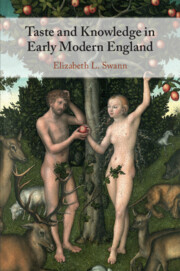Book contents
- Taste and Knowledge in Early Modern England
- Taste and Knowledge in Early Modern England
- Copyright page
- Dedication
- Contents
- Figures
- Acknowledgements
- Note on the Text
- Introduction
- Chapter 1 ‘To dream to eat Books’
- Chapter 2 Anatomizing Taste
- Chapter 3 From Eve’s Apple to the Bread of Life
- Chapter 4 ‘Those Fruits of Natural knowledge’
- Chapter 5 ‘Honey secrets’
- Afterword
- Bibliography
- Index
Chapter 2 - Anatomizing Taste
Practice, Subjectivity, and Sense in Mikrokosmographia
Published online by Cambridge University Press: 08 October 2020
- Taste and Knowledge in Early Modern England
- Taste and Knowledge in Early Modern England
- Copyright page
- Dedication
- Contents
- Figures
- Acknowledgements
- Note on the Text
- Introduction
- Chapter 1 ‘To dream to eat Books’
- Chapter 2 Anatomizing Taste
- Chapter 3 From Eve’s Apple to the Bread of Life
- Chapter 4 ‘Those Fruits of Natural knowledge’
- Chapter 5 ‘Honey secrets’
- Afterword
- Bibliography
- Index
Summary
This chapter turns to medical writing in order to probe the relationship between literary taste and taste as an object and faculty of empirical investigation. In anatomical textbooks – notably Crooke’s Mikrokosmographia – ‘taste’ slides referentially between gustation and readerly discrimination. Against a conventional scholarly supposition that anatomical history follows a trajectory away from classical authorities towards the empirical certainties of sense experience, I contend that this semantic flexibility emblematises an early modern insistence on the productive complementarity of proto-scientific empiricism and philological erudition, bodily sensation and mental judgement. The complementarity also has implications for our understanding of early modern subjectivities, pointing to a notion of selfhood that is simultaneously sensorially and textually inscribed, grounded both in physical experience and in the acquisition of knowledge.
Keywords
- Type
- Chapter
- Information
- Taste and Knowledge in Early Modern England , pp. 71 - 100Publisher: Cambridge University PressPrint publication year: 2020

